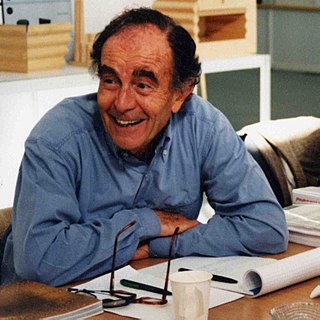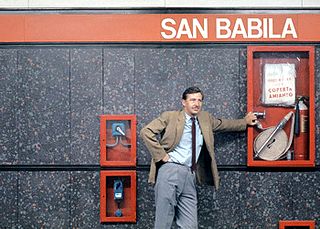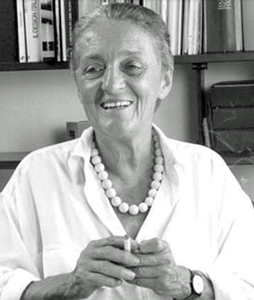Vito Noto is a born Italian, naturalized Swiss industrial designer.
Contents

Vito Noto is a born Italian, naturalized Swiss industrial designer.

Vito Noto was born in Ragusa, Italy, in 1955. His family moved to the Swiss Canton of Lucerne in 1958, then in 1969 to Canton Ticino.
He studied at the Scuola Politecnica di Design in Milan. After his studies he worked at various design studios in Zurich, Hamburg and Paris.
In 1982 he set up his own industrial design studio based in Cadro. With his team he has designed products for industries, furniture, graphic elements, website and machinery. He has received awards including: the Design Preis Schweiz, the Price Compasso d'Oro, and the IF Die gute Industrieform, ADI Design Index.
He teaches in technical institutes and universities. From 2005 to 2015 he held the position of President of the Photo Club of Lugano.

Ticino, sometimes Tessin, officially the Republic and Canton of Ticino or less formally the Canton of Ticino, is one of the 26 cantons forming the Swiss Confederation. It is composed of eight districts and its capital city is Bellinzona. It is also traditionally divided into the Sopraceneri and the Sottoceneri, respectively north and south of Monte Ceneri. Red and blue are the colours of its flag.

The Grisons or Graubünden, more formally the Canton of the Grisons or the Canton of Graubünden, is one of the twenty-six cantons of Switzerland. It has eleven districts, and its capital is Chur. The German name of the canton, Graubünden, translates as the "Grey Leagues", referring to the canton's origin in three local alliances, the Three Leagues. The other native names also refer to the Grey League: Grischùn in Sutsilvan, Grischun in the other forms of Romansh, and Grigioni in Italian. Rhaetia is the Latin name for the area. The Alpine ibex is the canton's heraldic symbol.

Olivetti S.p.A. is an Italian manufacturer of computers, tablets, smartphones, printers and other such business products as calculators and fax machines.
Events from 2005 in Switzerland.

Collina d'Oro is a municipality in the district of Lugano in the canton of Ticino in Switzerland. It was formed from the 2004 union of the villages of Agra, Gentilino, and Montagnola. On 1 April 2012, it incorporated the formerly independent municipality of Carabietta.

Vico Magistretti was an Italian architect who was also active as an industrial designer, furniture designer, and academic. As a collaborator of humanist architect Ernesto Nathan Rogers, one of Magistretti's first projects was the "poetic" round church in the experimental Milan neighbourhood of QT8. He later designed mass-produced appliances, lighting, and furniture for companies such as Cassina S.p.A., Artemide, and Oluce. These designs won several awards, including the Compasso d'Oro and the Gold Medal of the Chartered Society of Industrial Artists & Designers in 1986.

Richard Sapper was a German industrial designer who was based in Milan for much of his career. He is considered to be one of the most influential figures of post-war Italian design. His products typically feature a combination of technical innovation, simplicity of form, and an element of wit and surprise.
Antonio Citterio is an Italian architect, furniture designer and industrial designer who lives and works in Milan.
Technogym is a company selling equipment and digital technologies for fitness, sport and health based in Cesena, Italy. Technogym has been Official Supplier to eight Olympic Games including the Tokyo 2020 games. The company was founded in 1983 by Nerio Alessandri.
Stefan Diez is a German industrial designer whose Munich-based studio, DIEZ OFFICE, develops furniture, accessories, and exhibition designs.

Giulio Cappellini is the founder and art director of the eponymous Italian furniture company Cappellini based in Milan. In 2004 the Company became part of the Poltrona Frau Group. In 2021, it was acquired by the American office furnisher Haworth Inc.

Bob Noorda was a Dutch-born Italian graphic designer who lived and worked primarily in Milan from 1954 onwards. His works included design projects for major corporations and large-scale retail chains, publishing houses as well as public works such as the Milan Metro and NYC subway sign and image systems. During his career as a designer, Noorda created more than 170 logos for clients like Feltrinelli, Olivetti, Eni, Zucchi, Touring Club Italiano, Ermenegildo Zegna, and many others.

Lugano railway station is the main railway station of the city of Lugano, in the Swiss canton of Ticino. The station is on the Gotthard railway and is also the terminus of the Lugano Città–Stazione funicular. The metre gauge Lugano–Ponte Tresa Railway (FLP) has a separate station at Lugano FLP railway station across the station forecourt from the main line station.

Lodovico Migliore, nicknamed Ico, is an Italian architect, designer, professor and former professional ice hockey player. He is professor at the School of Design of the Polytechnic University of Milan and he is Chair Professor of the College of Design at Busan Dongseo University in South Korea. He served as chairman of Hockey Milano Rossoblu, an ice hockey team in Elite.A based out of Milan, Italy from 2010 to 2016. He also competed in the men's tournament at the 1984 Winter Olympics.

The Monte San Salvatore funicular, or Funicolare Monte San Salvatore, is a funicular railway in the city of Lugano in the Swiss canton of Ticino. The line links a lower station in the Lugano suburb of Paradiso with an upper station at the summit of the Monte San Salvatore. The top yields a 360° panorama with views of the city, Lake Lugano, Monte Generoso and the Italian enclave of Campione.

Generoso Vetta is the upper terminal railway station of the Monte Generoso railway, a rack railway that connects Capolago with the summit of Monte Generoso in the Swiss canton of Ticino. At 1,592 metres above sea level, it is the highest railway station in Ticino. The station is situated a short walk from the mountain summit, and only a few metres from the international border with the Italian region of Lombardy.

Anna Castelli Ferrieri was an Italian architect and industrial designer. She is most known for her influence in the use of plastics as a mainstream design material and her cofounding of Kartell, an Italian contemporary furniture company.
Clino Trini Castelli is an Italian industrial designer and artist. He has used the concept of "noform" through his work in environmental and industrial design, developed through the application of tools such as Design Primario and CMF design.
Michele de Lucchi is an Italian architect and designer.
Giovanni Orelli was a Swiss poet and writer who worked in Italian and the Ticinese dialect. His cousin Giorgio Orelli was a poet and literary critic.